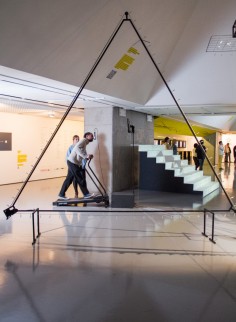Dmitry & Elena Kawarga
Down with Wrestlers with Systems and Mental Nonadapters!
file festival
source: fileorgbr
Abstract:
Do projeto especial da 4ª Bienal de Arte Contemporânea de Moscow 2011, “Rewriting Worlds: Dada Moscow”. Curador: Adrian Notz, Cabaret Voltaire, Zurique.
Uma pessoa deve correr em uma esteira para dar início ao processo (um mecanismo social). Por um lado, a pessoa sente-se como Deus, pois o movimento do mecanismo depende de seus passos, mas por outro, ele é apenas mais uma figura entre outras.
A consciência dos visitantes é dividida – a sociedade absorve cada um de nós? Ou nós mesmos nos absorvemos nesse mecanismo escravizador?
Se alguém se manifesta em um microfone falando “Dada”, a voz transfere um impulso de baixa frequência para a estrutura celular, que começa a vibrar. Como resultado, algumas das figuras caem, liberadas da estrutura.
Uma das correias possui uma microcâmera. Ela mostra em um monitor um espaço dentro de uma caixa preta – nessa caixa há uma outra realidade, o mundo do artista.
“A obra de Dmitry Kawarga normalmente lida muito com ideias de biomorfismo. Um termo e um pequeno ramo da história da arte que foi muito influenciado e formado por Hans Arp. Não se mantendo apenas no biomorfismo, como Arp, Kawarga acrescenta toda uma nova dimensão social e urbana às obras que nos fazem pensar em termos como “rizoma”, desenvolvido pelos pós-estruturalistas Deleuze e Guattari.
Em Dada Moscow, Kawarga inventou uma obra totalmente nova, que parece ser bem diferente das obras abstratas biomórficas que ele normalmente cria. É uma instalação interativa que traz à tona uma noção muito poderosa da fascinação pela máquina e pela tecnologia que tinha a sociedade antes da I Guerra Mundial e também mostra a consequência brutal que essa fascinação teve. Kawarga cria uma máquina que leva ao absurdo as ideias de modelos sociais”.
– Adrian Notz
Biography:
Dmitry e Elena Kawarga são dois dos poucos artistas russos que são especializados em arte high-tech. Suas obras mais recentes e significantes têm como base a síntese de arte e ciência e são criadas com cientistas e engenheiros. Instalações e objetos implicam um retorno biológico: eles respondem ao toque, ao ritmo do fluxo do corpo humano, à voz, instruções e estado mental.
.
.
.
.
.
.
.
source: fileorgbr
Abstract:
From the special project of 4th Moscow Bienalle of Contemporary Art 2011, ”Rewriting Worlds: Dada Moscow’.’ Curator: Adrian Notz, Cabaret Voltaire, Zurich.
One needs to go on a run simulator to start up the process (a social mechanism). On one hand, one feels himself as the God, because the moving of the mechanism depends on his steps and on the other hand he is only one figure amongst the others.
The consciousness of visitors is bisecting – does the society absorb each of us? Or are we ourselves absorbed by this enslaving mechanism?
If one tells in a microphone a manifesto ”Dada”, the voice transfers a low-frequency impulse to the cellular structure, which begins to vibrate. As a result some of the figures fall off, liberated from the structure.
One conveyor belt has a micro video camera. It shows on a monitor a space inside a black box – in this box there is another reality, the world of the artist.
“The work of Dmitry Kawarga normally deals a lot with ideas of biomorphism. A term and a small branch in art history that was very much influenced and formed by Hans Arp. Not just remaining in biomorphism, like Arp, Kawarga adds a whole new social and urban dimension to the works that make us think of terms like ”rhizome” developed by the post-structuralists Deleuze and Guattari.
For Dada Moscow, Kawarga invented a totally new work, which seems to be quite different from the abstract biomorph works he normally does. It is an interactive installation that brings up a very powerful sense of the machine and technology fascination the society before the WWI had and it also shows the brutal consequence this fascination had. Kawarga creates a machine that brings the ideas of social models totally to the absurd.”
– Adrian Notz
Biography:
Dmitry and Elena Kawarga are two of the very few Russians artists who are specialized in high-tech arts. The most significant recent works are based on science art synthesis and are created with scientists and engineers. Installations and objects imply a biological feedback; they respond to the touch, the rhythm of the human body flow, voice, briefing and state of mind.


